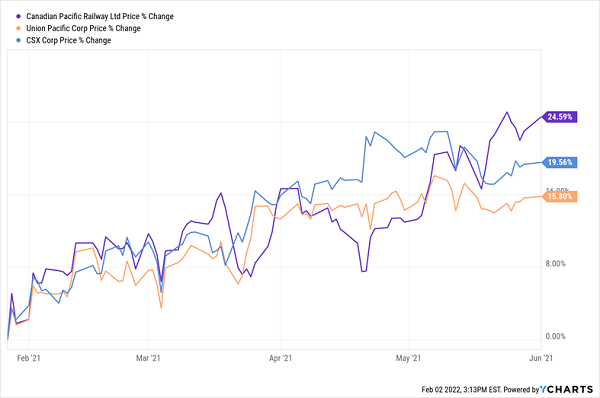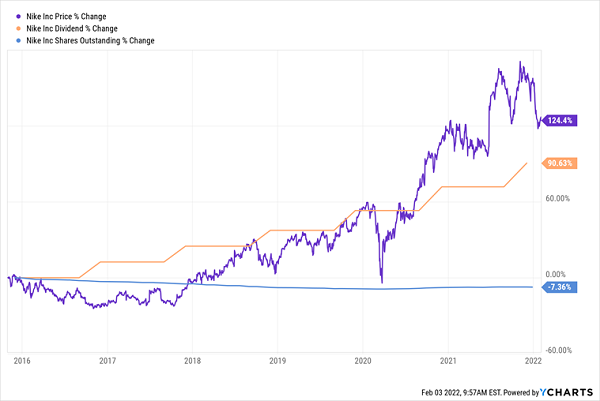Let’s set ourselves up for some quick 61%+ returns—and accelerate our dividend growth—by “front-running” stocks that are about to split their shares.
I call this my “Dividend Triple Play” strategy because, as you’ll see in a moment, it uses three critical indicators: a looming share split, dividend growth and share buybacks, to propel us to serious gains and payout hikes.
Members of my Hidden Yields dividend-growth service recently benefited from this setup—and it helped them walk away with a sweet 61% return! It’s easy to repeat, and I’ll even give you the ticker of another stock that could be our next high-flying “dividend splitter” below.
How Our Last “Dividend Split” Drove a Fast 61% Return
That 61% return came via our holding in Canadian Pacific Railway (CP), which shows us the power of splits to immediately move share prices.
When CP announced it would split its stock 5-for-1 on January 27, 2021, we grabbed an immediate share-price pop, and CP ran out to a consistent lead over rivals CSX Corp. (CSX) and Union Pacific (UNP) until well after the split happened on May 14:
CP Splits, Rolls Ahead of the Pack

CP turned out to be a great buy, handing us that 61% return (including a 14.5% dividend hike, in Canadian currency) from the time we bought on April 14, 2020, to our sale date on December 21, 2021.
Share Splits Are About More Than Price
So what’s going on here? After all, CP’s share split didn’t change its actual value. When the markets closed on May 13, 2021, the day before the split took effect, our shares were worth $400 apiece—and when the markets opened the next day, they dropped to $80.
A drop like that can cause heart palpitations when you open your account … until you realize you have five times more shares, so the overall value of your holding stays the same. (The just-announced Alphabet [GOOGL] share split was a highly unusual 20-for-1 split. That would slash the stock’s price from around $2,970 a share to somewhere in the neighborhood of $148!)
There are two reasons why stocks gain post-split:
- Management has confidence—and wants you to know it. And if your splitter pays a dividend (as it should!), this could foretell a big payout hike (or a string of them). That, combined with the split and share buybacks, forms our “triple play” and positions you for dividend-powered profits.
- Splits get around the bias against “high-priced” stocks, even though we all know a stock’s price doesn’t really matter—at best it’s half the equation and must be held up against earnings, sales, cash flow or other metrics to tell us anything meaningful about a company’s value.
There are lots of reasons why folks get hung up on price. For example, if you’ve been investing for a while, you might still think of buying shares in “round lots”—and a lot of 100 was the smallest you could buy years ago (even though you can buy any number now, and even fractions of shares with some brokerages).
And let’s be honest—it’s just more fun to buy more shares! Dropping $20,000 to buy a measly six shares of Amazon.com (AMZN) or 54 shares of $370-trader Home Depot (HD)—more on HD below—is underwhelming compared to scoring 569 shares of the aforementioned CSX Corp., one of the “cheapest” stocks in the S&P 500 (due to its five stock splits!) at around $35.
Our Split-Driven “Dividend Triple Play” Strategy in Action
As I said above, share splits are only part one of our strategy here: the real key is to look for companies that not only have “high” share prices but also grow their dividends (as we did with CP), and even better if they’re also buying back shares.
Holding potential splitters like these can really pay off. Consider the case of Nike (NKE), which announced a 2-for-1 stock split, a 14% dividend hike and a $12-billion share-repurchase program all in one go back on November 19, 2015.
The stock immediately popped 4% on the news, then proceeded to ride higher as the company’s “Dividend Magnet”—the reliable pattern of dividends pulling share prices higher as they rise—went to work, pulling the shares up with each hike, as you can see below.
Share Split Is the “Starting Pistol” for Nike’s Payout-Powered Gains

Meanwhile, the buyback (shown by a drop in the number of shares outstanding in the blue line above) has thrown a floor under the share price, giving the payout an assist as it pulls the stock higher.
This Could Be Our Next “Dividend Triple Play” Winner
That brings us back to Home Depot, which is trading around $371 as I write this. That “high” price is one sign a split could be in the offing.
Another? History: the company has split its stock 13 times in the past, but it hasn’t done so since way back in 1999. That, plus its high share price—it’s down from all-time levels of around $416 prior to this latest pullback—tells us it’s way overdue.
Dividend growth and share buybacks? Check and check.
Dividends and Buybacks Go to Work. Share Split Next?

It’s true that HD’s price has gotten ahead of its dividend, but we’re still hanging on to the stock, which has handed my Hidden Yields subscribers a tidy 39% return in the 16 months we’ve owned it.
HD continues to profit from the work-from-home trend, which, now that people have had a taste of it, are loath to give up. A home office means more home improvements, because when people aren’t on Zoom, they’re staring at their house, thinking of ways to upgrade it. HD is continuing to profit from this megatrend.
You can see that in the retailer’s average ticket, which rose 13% in the latest quarter as shoppers buy more every time they come in (or fill their online cart). That, plus HD’s safe payout ratio (it devotes 46% of its earnings to dividends) gives it plenty of room to keep hiking its payout and buying back stocks.
A share split? Consider it an extra tool in HD’s kit.
7 “Inflation-Proof” Dividends Set to Soar 15%—Year in and Year Out
Dividend growth is the driving force behind the 7 dividend-growth stocks I’m urging investors to buy today. I’ve handpicked these companies to ride their surging payouts (and possible share splits) to 15% returns—year in and year out.
They’re the perfect plays for today’s inflation-panicked markets because their buybacks and rising dividends help stabilize their share prices when stocks drop, then light a fire under them when the inevitable rebound arrives.
I call these companies “hidden yield” stocks because the herd doesn’t appreciate the many ways they pay us—through a current dividend, dividend growth and price upside, thanks in part to their bargain valuations.
Now is the time to grab a position. Click here and I’ll give you full details on these 7 outstanding dividend payers (and growers!), including their names, tickers, dividend histories and everything else you need to know.
